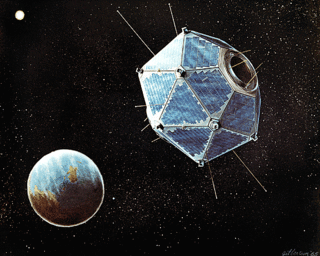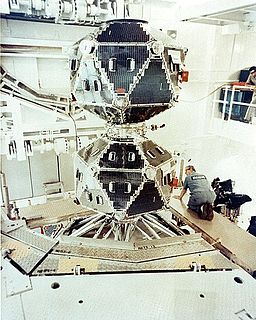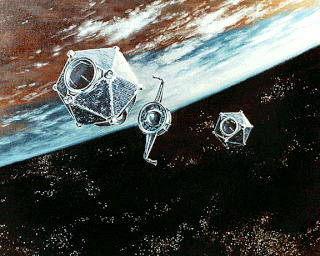Related Research Articles

Vela was the name of a group of satellites developed as the Vela Hotel element of Project Vela by the United States to detect nuclear detonations to monitor compliance with the 1963 Partial Test Ban Treaty by the Soviet Union.

Project Vela was a project undertaken by the United States Department of Defense to develop and implement methods to monitor compliance with the 1963 Partial Test Ban Treaty. This treaty banned the testing of nuclear weapons in the atmosphere, in outer space, and underwater, effectively meaning nuclear tests were only to be permitted underground.
The history of gamma-ray began with the serendipitous detection of a gamma-ray burst (GRB) on July 2, 1967, by the U.S. Vela satellites. After these satellites detected fifteen other GRBs, Ray Klebesadel of the Los Alamos National Laboratory published the first paper on the subject, Observations of Gamma-Ray Bursts of Cosmic Origin. As more and more research was done on these mysterious events, hundreds of models were developed in an attempt to explain their origins.

Orbiting Vehicle or OV, originally designated SATAR, comprised five disparate series of standardized American satellites operated by the US Air Force, launched between 1965 and 1971. Forty seven satellites were built, of which forty three were launched and thirty seven reached orbit. With the exception of the OV3 series and OV4-3, they were launched as secondary payloads, using excess space on other missions. This resulted in extremely low launch costs and short proposal-to-orbit times. Typically, OV satellites carried scientific and/or technological experiments, 184 being successfully orbited through the lifespan of the program.

OPS 0855, also designated OV4-3, was an American boilerplate Manned Orbiting Laboratory spacecraft launched in 1966. It was flown to demonstrate the launch configuration for future MOL missions. A number of research payloads, designated Manifold, were carried on board, which were intended to operate for 75 days. However, the spacecraft ceased operations after just 30 days. It was built from a decommissioned HGM-25A Titan I first stage oxidizer tank, bolted to a Transtage. It was part of the MOL and Orbiting Vehicle projects.

An X-ray astronomy satellite studies X-ray emissions from celestial objects, as part of a branch of space science known as X-ray astronomy. Satellites are needed because X-radiation is absorbed by the Earth's atmosphere, so instruments to detect X-rays must be taken to high altitude by balloons, sounding rockets, and satellites.

This article documents notable spaceflight events during the year 2019.

Mikhailo Lomonosov is an astronomical satellite operated by Moscow State University (MSU) named after Mikhail Lomonosov.

Vela 2A, also known as Vela 3, Vela Hotel 3 and OPS 3662, was a U.S. military satellite developed to detect nuclear detonations to monitor compliance with the 1963 Partial Test Ban Treaty by the Soviet Union. The secondary task of the ship was space research.

Vela 2B was a U.S. reconnaissance satellite for detecting explosions and nuclear tests on land and in space, the first of the second pair of Vela series satellites, taken together with Vela 2A and ERS 13 satellites. The secondary task of the ship was space research.

Vela 3A was a U.S. reconnaissance satellite to detect explosions and nuclear tests on land and in space; the first of the third pair of Vela series satellites; taken together with Vela 3B and ERS 17 satellites.

Vela 3B was a U.S. reconnaissance satellite to detect explosions and nuclear tests on land and in space; the first of the third pair of Vela series satellites; taken together with Vela 3A and ERS 17 satellites.
Vela 4B was an American reconnaissance satellite to detect explosions and nuclear tests on land and in space. It was released together with Vela 4A, ERS 18, OV5 1 and OV5 3.

Vela 5A was an American reconnaissance satellite to detect explosions and nuclear tests on land and in space. It was released together with Vela 5B, OV5 5, OV5 6 and OV5 9.

Orbiting Vehicle 2-1, the first satellite of the second series of the United States Air Force's Orbiting Vehicle program, was an American life science research satellite. Its purpose was to determine the extent of the threat posed to astronauts by the Van Allen radiation belts. Launched 15 October 1965, the mission resulted in failure when the upper stage of OV2-1's Titan IIIC booster broke up.

Orbiting Vehicle 1-2, launched 5 October 1965, was the third, and first successful, satellite in the OV1 series of the United States Air Force's Orbiting Vehicle program. A radiation measuring satellite designed to conduct research for the planned Manned Orbital Laboratory project, OV1-2 was the first American spacecraft to be placed into orbit on a western trajectory. The satellite stopped functioning in April 1967 after a series of technical problems starting two months after launch.

Orbiting Vehicle 2-3, the second satellite of the second series of the United States Air Force's Orbiting Vehicle program, was an American solar astronomy, geomagnetic and particle science research satellite. Launched 22 December 1965 along with three other satellites, the mission resulted in failure when the spacecraft failed to separate from the upper stage of its Titan IIIC.

Orbiting Vehicle 1-7, launched 14 July 1966, was the sixth satellite launched in the OV1 series of the United States Air Force's Orbiting Vehicle program. OV1-7 was a sky science satellite, designed to return data on charged particles in orbit as well as measurements of solar X-rays and nightglow. Co-launched with OV1-8, the satellite was lost when it failed to detach from its launch rocket.

The Environmental Research Satellite program was a series of small satellites initially operated by the United States Air Force Office of Aerospace Research. Designed to be launched "piggyback" to other satellites during launch, detaching once in orbit, they were the smallest satellites launched to date—what would today be classified as microsatellites. 33 ERS satellites in six different series were launched between 1962 and 1971, conducting scientific research and serving as test beds to investigate the reliability of new spacecraft components.

Cosmic X-ray Background Nanosatellite-2 was a satellite and mission developed by the Morehead State University to follow up on the CXBN mission launched in 2012. It was an improved version of the previous spacecraft and it increased the precision of measurements of the cosmic X-ray background in the 30-50 keV range and helped to improve understanding of the early universe.
References
- ↑ NASA Goddard Space Flight Center. "Vela 4A" . Retrieved 28 September 2019.
 This article incorporates text from this source, which is in the public domain .
This article incorporates text from this source, which is in the public domain . - ↑ Ford, Dominic. "OPS 63". InThe-Sky.org. Retrieved 28 September 2019.
- ↑ Antonín Vítek. "1967-040A - Vela 7". Space 40. Retrieved 28 September 2019.
- ↑ Krebs, Gunter. "Vela 7, 8, 9, 10, 11, 12 (advanced Vela)". Gunter's Space Page. Retrieved 28 September 2019.